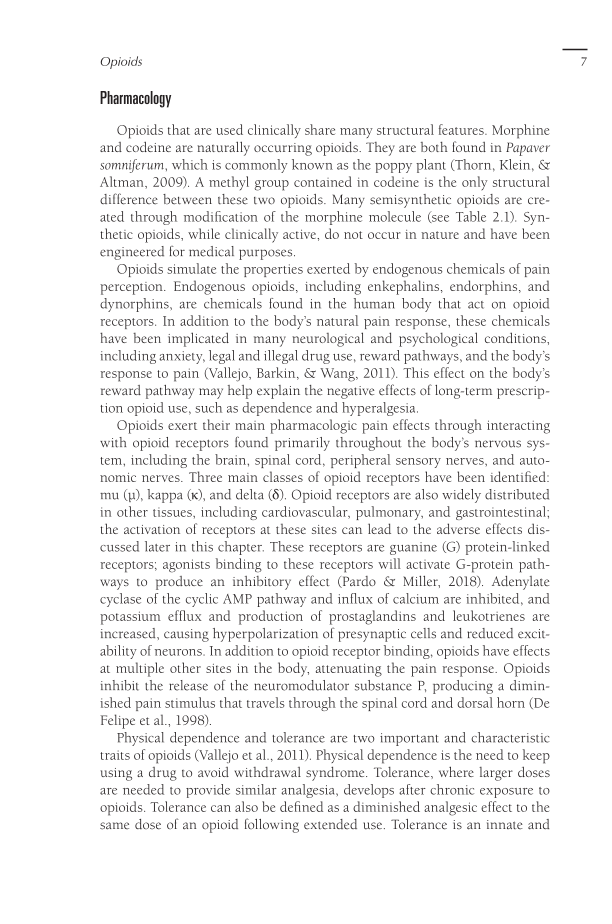Opioids 7 Pharmacology Opioids that are used clinically share many structural features. Morphine and codeine are naturally occurring opioids. They are both found in Papaver somniferum, which is commonly known as the poppy plant (Thorn, Klein, & Altman, 2009). A methyl group contained in codeine is the only structural difference between these two opioids. Many semisynthetic opioids are cre- ated through modification of the morphine molecule (see Table 2.1). Syn- thetic opioids, while clinically active, do not occur in nature and have been engineered for medical purposes. Opioids simulate the properties exerted by endogenous chemicals of pain perception. Endogenous opioids, including enkephalins, endorphins, and dynorphins, are chemicals found in the human body that act on opioid receptors. In addition to the body’s natural pain response, these chemicals have been implicated in many neurological and psychological conditions, including anxiety, legal and illegal drug use, reward pathways, and the body’s response to pain (Vallejo, Barkin, & Wang, 2011). This effect on the body’s reward pathway may help explain the negative effects of long-term prescrip- tion opioid use, such as dependence and hyperalgesia. Opioids exert their main pharmacologic pain effects through interacting with opioid receptors found primarily throughout the body’s nervous sys- tem, including the brain, spinal cord, peripheral sensory nerves, and auto- nomic nerves. Three main classes of opioid receptors have been identified: mu (μ), kappa (κ), and delta (δ). Opioid receptors are also widely distributed in other tissues, including cardiovascular, pulmonary, and gastrointestinal the activation of receptors at these sites can lead to the adverse effects dis- cussed later in this chapter. These receptors are guanine (G) protein-linked receptors agonists binding to these receptors will activate G-protein path- ways to produce an inhibitory effect (Pardo & Miller, 2018). Adenylate cyclase of the cyclic AMP pathway and influx of calcium are inhibited, and potassium efflux and production of prostaglandins and leukotrienes are increased, causing hyperpolarization of presynaptic cells and reduced excit- ability of neurons. In addition to opioid receptor binding, opioids have effects at multiple other sites in the body, attenuating the pain response. Opioids inhibit the release of the neuromodulator substance P, producing a dimin- ished pain stimulus that travels through the spinal cord and dorsal horn (De Felipe et al., 1998). Physical dependence and tolerance are two important and characteristic traits of opioids (Vallejo et al., 2011). Physical dependence is the need to keep using a drug to avoid withdrawal syndrome. Tolerance, where larger doses are needed to provide similar analgesia, develops after chronic exposure to opioids. Tolerance can also be defined as a diminished analgesic effect to the same dose of an opioid following extended use. Tolerance is an innate and
Document Details My Account Print multiple pages
Print
You have printed 0 times in the last 24 hours.
Your print count will reset on at .
You may print 0 more time(s) before then.
You may print a maximum of 0 pages at a time.











































































































































































































































































































































